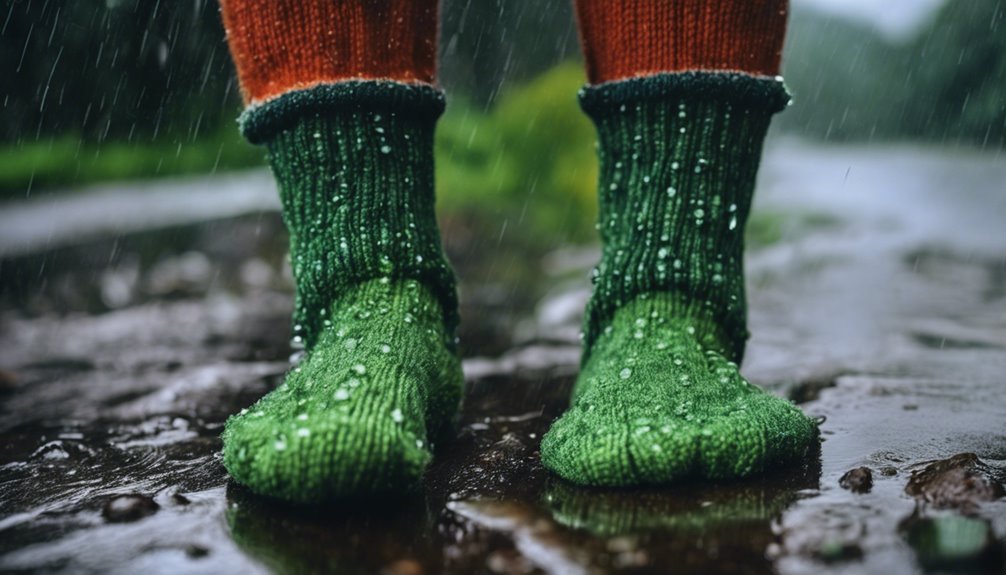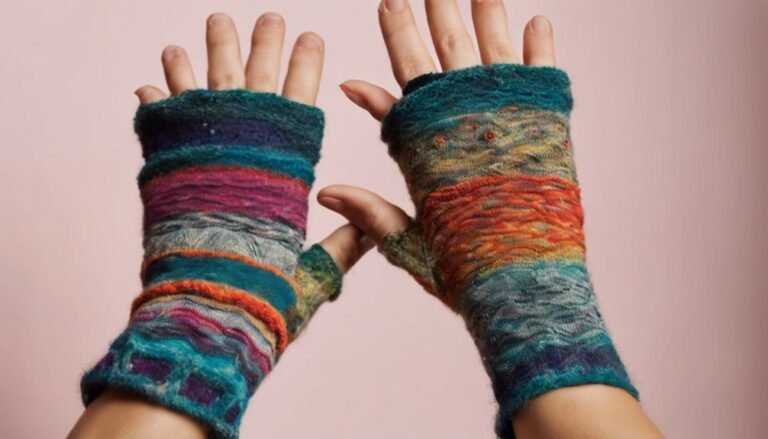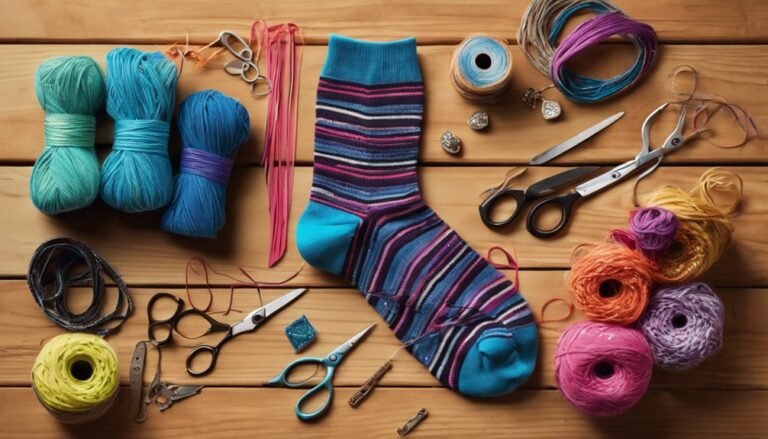Using Socks as Makeshift Gloves in an Emergency
Have you ever noticed how socks can be more than just footwarmers? Imagine you're on a winter hike, and suddenly, the chill in the air becomes unbearable, but you forgot your gloves.
What if I told you that those cozy socks in your backpack could save the day? Yes, socks can be your go-to solution for makeshift gloves in an emergency. Choose thick wool or fleece-lined socks for maximum warmth and insulation. Secure them with rubber bands for a snug fit, and use plastic bags for waterproofing in wet conditions.
Socks also protect against dirt and grime, proving handy during messy tasks. Keep a spare pair in your car or backpack for unexpected moments and explore more practical uses with this versatile item.
Choosing the Right Sock Material

Selecting the appropriate sock material is essential when you're using socks as makeshift gloves in an emergency. You want to focus on sock fabrics that offer the best insulation properties to keep your hands warm and functional. Cotton socks, while soft, don't provide good insulation when wet, so they're best avoided. Instead, consider synthetic blends, which offer decent warmth and moisture-wicking capabilities. If you've got access to fleece-lined socks, they're an excellent choice due to their superior insulation properties. Pay attention to thickness too; thicker fabrics will generally offer more warmth. Remember, freedom's about being prepared and adaptable. Choosing the right sock material can make a significant difference in maintaining your dexterity and comfort in unexpected situations.
Maximizing Warmth With Wool Socks
When it comes to maximizing warmth, wool socks are your best ally in an emergency. Their natural wool insulation is unmatched, offering superior thermal retention that keeps your hands snug even in biting cold. You'll appreciate how wool fibers trap heat, creating a protective barrier against the chill. To make the most of your wool socks, choose a pair with a thick, dense weave. This enhances insulation, ensuring maximum warmth. Slide your hands into these cozy confines, and let the wool do its magic. Remember, freedom is in the details, so if you have a choice, go for merino wool—it's soft, lightweight, and itch-free. In a pinch, these wool wonders will keep you warm, freeing you from the cold's grip.
Protecting Hands From Dirt and Grime

Although you might not have gloves at hand, socks can serve as a practical alternative to protect your hands from dirt and grime in an emergency. Slip them over your hands to create an effective dirt protection layer. Choose thick, durable socks for a stronger grime barrier. This makeshift solution is especially handy when you're tackling unexpected, messy tasks in the great outdoors or dealing with a quick fix at home. They'll keep your hands cleaner and shield them from unwanted contact with dirt and grime. Plus, socks are often more accessible than gloves, giving you the freedom to act swiftly when needed. Keep a spare pair in your backpack or car, ready to jump into action when the situation demands.
Enhancing Grip for Manual Tasks
While socks can keep your hands clean, they also offer a surprising benefit: enhancing your grip during manual tasks. By slipping on a pair, you'll experience enhanced dexterity and improved traction, ideal for those moments when freedom is essential. Envision this:
- Grasping Tools: Whether it's a wrench or screwdriver, socks improve traction, ensuring tools don't slip.
- Carrying Boxes: The added texture of fabric helps hold onto awkward or heavy items more securely, preventing drops.
- Opening Jars: A snug sock provides just enough friction to twist open stubborn lids effortlessly.
In emergencies, resourcefulness is key. Using socks as makeshift gloves empowers you to tackle tasks with confidence and precision, even when traditional gloves aren't available. Embrace this clever hack and enjoy the liberty it brings.
Keeping Hands Dry in Wet Conditions

When you're caught in wet conditions, keeping your hands dry is essential, and a simple way to waterproof your sock gloves is by using plastic bags. Slip a plastic bag over each sock-covered hand and secure it with a rubber band or string around your wrist to prevent water from seeping in. For added warmth, layer another pair of socks over the plastic, creating a barrier that retains heat while keeping moisture out.
Waterproofing With Plastic Bags
In a pinch, a plastic bag can be a surprisingly effective tool for waterproofing your hands when you're using socks as gloves. When you're caught in wet conditions, having this bit of emergency gear can be a game-changer. Here's how you can make the most of it:
- Select sturdy bags: Opt for thick, durable plastic bags to serve as a waterproof barrier.
- Secure the fit: Slide your sock-covered hands into the bags and use a rubber band to hold them snugly at the wrists.
- Ensure coverage: Check that the bag covers the entire sock layer to prevent any water from seeping in.
Layering for Extra Warmth
Even though you're using socks as makeshift gloves, adding layers can greatly enhance warmth and keep your hands dry in damp conditions. Start with a thin, close-fitting sock for the first layer. This creates a thermal insulation base. Add a thicker, wool sock over it for enhanced warmth. For wet environments, wrap a plastic bag over both layers to keep moisture out. Secure it with a rubber band, guaranteeing it's snug but not too tight. This layering technique maximizes warmth and guarantees your hands stay dry. Here's a quick guide:
| Layer | Material |
|---|---|
| Base | Thin sock |
| Insulation | Wool sock |
| Waterproofing | Plastic bag |
| Securing | Rubber band |
With these simple steps, you're free to face the elements with confidence.
Using Socks for Temporary First Aid
Socks can be surprisingly versatile, especially in emergency situations where you need immediate first aid. When traditional supplies are scarce, socks materials can be your go-to for emergency preparedness. Here's how you can use them:
- Bandage Substitute: Cut the sock into strips and wrap it around a wound to apply pressure and stop bleeding.
- Padding and Cushion: Fold a sock to create a soft layer to protect a sprain or cushion a blister.
- Tourniquet Alternative: In dire circumstances, a sock can be twisted tightly to act as a makeshift tourniquet, slowing blood flow.
Socks are lightweight, easy to carry, and offer a quick solution to unexpected situations, giving you the freedom to handle emergencies with ingenuity and calm.
Creative Solutions for Outdoor Adventures
When emergencies arise, having versatile tools at your disposal is invaluable, and outdoor adventures often call for creative problem-solving with whatever's on hand. Imagine you've forgotten your outdoor gear. A pair of socks can transform into mittens, keeping your hands warm. You can also use them as a filter for murky water or to wrap a makeshift sling.
Here's how socks can serve you in a pinch:
| Situation | Solution | Outcome |
|---|---|---|
| Cold hands | Socks as mittens | Warmth and comfort |
| Dirty water | Sock filter | Cleaner water |
| Arm injury | Sock sling | Stabilized support |
| Protecting food | Sock pouch | Safe storage |
| Emergency signaling | Sock flag | Attention grabbed |
Embrace these survival tips and explore with confidence.
Quick Fixes for Household Chores
When you're in a pinch and need to protect your hands while cleaning, an old sock can be your best friend. Simply slip it over your hand to create a versatile cleaning solution for dusting or scrubbing without worrying about damaging your skin. This quick fix is especially handy for tackling those unexpected spills or messes around the house.
Protecting Hands Effectively
Even though socks might not be the first thing you think of when you need to protect your hands, they can be surprisingly effective in a pinch. You'll find that socks offer hand warmth and an unexpected layer of protection during emergency preparedness. When you need to tackle household chores and your hands need shielding, consider these quick fixes:
- Dusting: Use socks to cover your hands for dusting surfaces. Their texture picks up dust effortlessly.
- Gardening: Slip on socks to shield your hands from dirt and minor scratches while tending to plants.
- Dishwashing: Protect your hands from hot water and detergent by wearing socks as temporary gloves.
This resourceful approach not only keeps your hands safe but also allows you to act independently and ready for anything.
Versatile Cleaning Solution
A versatile cleaning solution can transform how you tackle household chores, especially when you're short on time and supplies. Imagine using socks as a practical cleaning tool. Slipping one over your hand, you've got an instant dusting mitt, perfect for reaching tight spots like blinds or baseboards. This cleaning hack is not only eco-friendly but also a great way to reuse worn-out socks. In an emergency where cleaning supplies are scarce, this simple swap can save the day. Just dampen the sock slightly for a quick wipe-down of surfaces or add a drop of your favorite cleaner for an extra shine. This approach gives you the freedom to maintain a clean space without the usual constraints, offering both efficiency and ingenuity.
Transforming Socks Into Fingerless Gloves
If you find yourself in a pinch and need a quick pair of fingerless gloves, transforming a pair of socks can be a surprisingly effective solution. With a few sock modifications, you can create a fashion alternative that provides both warmth and freedom. Here's how you can do it:
- Select the Socks: Choose a pair with a little stretch. Thick, warm socks are ideal for retaining heat.
- Cut the Toe Area: Snip off the toe section to make room for your fingers. Make sure not to cut too much, just enough to allow movement.
- Create Thumbholes: Make a small incision on the side for your thumb. This step guarantees the glove stays in place.
These simple steps offer practical freedom and warmth in emergencies.
Frequently Asked Questions
How Do You Secure Socks to Stay on Hands During Use?
When the world feels like it's slipping through your fingers, secure socks with rubber bands or twist ties. These sock fastening techniques guarantee emergency hand protection, allowing you to act freely and confidently in unexpected situations.
Can Socks Be Used as Gloves for Children in Emergencies?
Yes, you can use socks as gloves for children, offering warmth in emergencies. Make certain they fit snugly for effectiveness. In emergency preparedness, always prioritize comfort and functionality, allowing kids to maintain freedom of movement while staying protected.
Are There Any Safety Concerns With Using Socks as Gloves?
Worried about safety hazards? Socks might not protect against sharp objects or extreme temperatures. Verify they're free from material allergies by checking labels. While practical in a pinch, they're not a long-term solution. Stay resourceful and cautious!
What Types of Socks Are Most Durable for Repeated Use?
You're wondering about durability? Wool socks are your best bet for repeated use; they're tough and insulating. Cotton socks, while comfortable, wear out faster. For those seeking freedom, prioritize wool for reliability in various situations.
How Do You Clean Socks After Using Them as Gloves?
Did you know 90% of bacteria can be removed by washing at 60°C? For sock cleaning techniques, use hot water and antibacterial soap. It's crucial for emergency preparedness essentials—ensuring you're ready for anything with clean, versatile gear.







